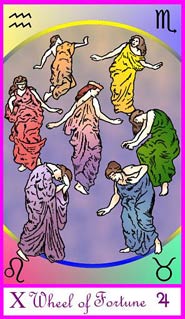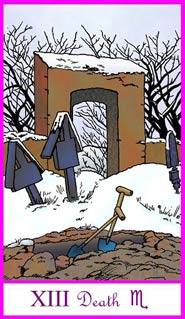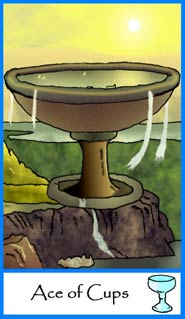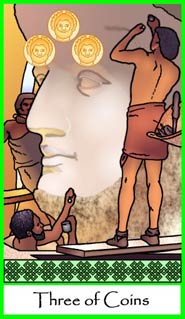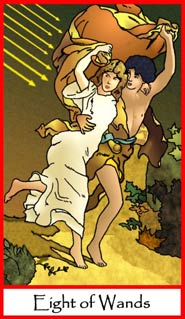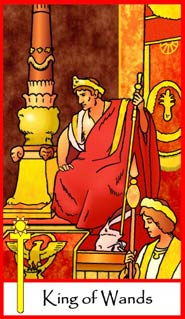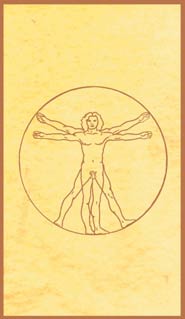Tarot of the Masters Deck Review
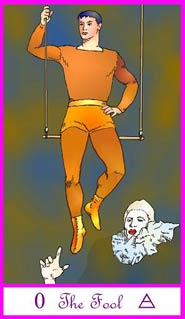
Creators: James Ricklef
Publisher: Self Published 2008
The Tarot of the Masters is from Tarot author James Ricklef, and is inspired by classical paintings from the old masters. Unlike most decks with the similar theme, this deck was drawn in pen and ink and coloured on the computer and has a uniform look across the cards. It's been self-published in a first edition run of 55 decks.
Retailers
See Price at James RicklefTarot of the Masters Review by Bonnie Cehovet
"Tarot of the Masters" is the latest effort from Tarot author/teacher/lecturer James Ricklef (Tarot Tells the Tale and Tarot: Get the Whole Story). James is known not only for the superb quality of his writing, but for his in-depth understanding of the Tarot, and his unique manner of presentation.
Inspired by classic paintings from old masters such as Rembrandt, Toulouse-Lautrec, Bouguereau, Rubens, and Hieronymus Bosch, this deck follows traditional lines – 78 cards, traditional titles (with the exception of the Devil, which has been retitled Demons, and the Hierophant, which has been retitled the High Priest), Strength as VIII and Justice as XI. The suits are titled Wands, Cups, Swords, and Coins, with the Court Cards titled King, Queen, Knight, and Youth.
The deck comes shrink wrapped, in a lovely satin bag, with a signed and numbered Authenticity Card. (There are 55 copies printed in this first run.) There is no LWB (Little White Book), or companion book, but James does give a link to an online “Tarot of Masters” book that, while it is still a work in progress, James hopes to publish in the future.
The online information on each card includes the inspiration for each card, and a discussion of the meanings in terms of the original painting, as well as the traditional meaning of the card. James notes that at times there may be a disparity between the card image and the traditional card meaning. What we need to consider here is that the images on the cards are meant to deepen and expand our understanding, opening up new possibilities, rather than restricting the reader’s options.
In this material James uses the term “Higher Self” in a very general manner, with no specific cultural context. He sees our Higher Self as being that part of us that transcends physical reality and the material world. In this manner, the reader is free to associate whatever term they use for this concept.
James goes on to say that he has taken some liberties in placing the suit icons, in that he has arranged them in positions that he feels may spark insights on their own.
From James’ site:
0. The Fool
Artistic reference: Le Trapeziste Et La Clown by Charles Giron
The inspiration for many of the cards in this deck arose easily as I perused through hundreds of works of art, partly because the evolution of the Tarot paralleled the development of art in post-Medieval Western culture. This was not the case, however, for all of the cards, and the Fool falls into this latter category. This is not to say that I could not find paintings that could be used for this card, for indeed there are more than enough paintings of court jesters and clowns, and a few titled “Ship of Fools” (including one by Hieronymus Bosch that I almost used). But none of them quite captured the breadth of meaning that I associate with this card until I came across Giron’s painting of a trapeze artist and a clown together.
In this image, we see two very disparate facets of the fool. The use of a clown on the Fool card needs no explanation, but a trapeze artist? The reason I found this figure so apt for this card is because of his defining action – flying through the air as he lets go of one trapeze prior to grasping another. What a quintessential leap of faith that must be. And so we see here someone doing something that others may find foolish, and indeed, it does seem as if he (the trapeze artist) is being mocked by the clown in this illustration. But we have to wonder, which of them is the fool – the man who is about to leap through the air or the one dressed outlandishly, but planted firmly on the ground? Or perhaps each in his unique way is a fool – or an adventurer, or an iconoclast , etc. – and so this card can even call into question the meaning of what a fool is.
Common Meanings:
The Fool card is the only card in the Tarot deck to be numbered “Zero,” which relates it to a host of meanings, including the concept of absolute potentiality – an existence without restrictive definitions of “What Is” or “What Should Be.” This number is represented by a circle, which symbolizes eternity since it has no beginning and no end, and Zen Buddhists have a concept called Ensō, meaning "circle," that has similar connotations of eternity, the void, and spiritual wholeness. Perhaps it is through such considerations that some people refer to this card as the God Card and consider it representing someone touched by Divinity.
The typical image on the Fool card calls to mind a couple of sayings that seem to be at odds: “Look before you leap” and “Leap and the net will appear.” In other words, it can indicate taking foolish risks or taking a leap of faith. So on the one hand, we can see here the common attribute of foolishness or buffoonery, but on the other hand, we can see in this card the proverbial Wise Fool, i.e., an enlightened person who is seen as a fool by the rest of the world. But rather than being a detriment to understanding, this contradiction actually expresses some of the rich diversity of meaning we can attach to this card, and whichever sense appears more appropriate when this card comes up is an important clue to what the card is telling you at that time.
We can also find common ground between these opposing meanings when we realize that it is precisely a buffoon – someone unfettered by the constraints of ego and social dogma – who is the best conduit for divine inspiration. Consequently, we can see the Fool card as representing all the innovative things we can do if we don’t listen to everyone telling us that we cannot do them. In other words, the Fool “marches to the beat of a different drummer.” Similarly, the Fool is someone with simplicity of heart and an innocent optimism who also may be blessed with “dumb luck.” He is a wanderer or a seeker, and he is a free spirit with an indomitable nature.
The following are a few quotes that present interesting interpretations for the Fool:
- “A fool's paradise is a wise man's hell!” – Thomas Fuller
- “If the fool would persist in his folly he would become wise.” – William Blake
- “Fools rush in where angels fear to tread.” – Alexander Pope
- “Lord, what fools these mortals be!” – William Shakespeare (A Midsummer Night’s Dream, act 3, sc. 2. In this quote, the speaker, Puck, is referring to the actions of lovers.)
- “Truth is found in the mouths of babes and fools.” (This quote is purported to be a Sephardic proverb)
Astrological Association:
The Hermetic Order of the Golden Dawn, a turn of the century mystical order, assigned each of the cards in the Tarot’s Major Arcana an astrological association. Twelve of the cards were related to the signs of the zodiac, seven to the planets of classical astrology, and three were attributed to three of the alchemical elements: Fire, Water, and Air, each of which rules astrological three signs. Since that time, the three cards assigned elemental symbols have been associated with the three modern planets.
I have indicated the Golden Dawn associations on the Major Arcana cards in the Tarot of the Masters, and I mention them here for the sake of anyone interested in further exploring these relationships and what they contribute to an understanding of these cards.
Under the Golden Dawn’s system, the Fool card is associated with elemental Air. It is also associated with the planet Uranus.”
The cards are 3” by 4 ¾”, on 12 point, coated card stock. The non-reversible backs show a ¼” white border, surrounding a finer maroon colored inner border. The background color for the inset is beige, with a maroon colored line drawing of Leonardo Da Vinci’s “Vitruvian Man” as the inset.
The card faces show the same border structure, with the number (in Roman Numerals) and title of the Major Arcana, along with planetary, astrological, or elemental sign glyphs across the bottom of the card. The Pips (numbered cards) show the number and suit across the bottom of the card, while the Court Cards show the title and suit across the bottom of the card. The style of the artwork is part reality, part fantasy, and varies from card to card as it should – after all, it is based on a number of different artists work, not on the work of one artist.
Many of the cards in this deck fascinated me – starting with the Fool. Here we see a male figure, in red shirt and tights, with golden shoes, sitting on a trapeze. In the lower right hand corner we see the head of a clown. Disparate energies that are both associated with the Fool.
The Chariot is unique in that we see a male Charioteer standing on a flat platform, with two horses in front – one dark, one light, both with riders. Across the bottom of the card, right above the title, we see a center Yin/Yang symbol, with the theater masks of tragedy and comedy to either side.
The Wheel of Fortune is one of my favorite cards, showing six female figures dancing around one central female figure. James notes that the figures in the circle seem to be going through the dramas of life, while the figure in the center watches with detachment. In the four corners we see the glyphs for the four fixed signs.
The Hanged Man is hanging from a tree limb by one foot, with the other crossed behind him in the traditional manner. His hands are free, and fall downward from the body. What I find interesting here are the gold coins that seem to be falling to the ground – as if from his hands.
Death is a fascinating card, showing two shovels in the ground, indicating that a grave is in the process of being dug. Snow is on the ground, and there are barren trees in the background. There is an open doorway behind the grave that James feels suggestive of renewal and new possibilities.
The World is a card that one cannot look at once and think that they “have it”. The central shape is a mandorla (a luminescent almond shape), with four traditional figures surrounding it (a winged man, an eagle, an ox, and a lion). The central figure (within the mandorla) is that of an angel, writing on a scroll that rests on a globe.
I was impressed with the placement of the icons on the Pips as not being necessarily “traditional”. The Four of Wands shows great balance with two wands on either side of the card title (as does the Six of Wands – with three wands on either side of the title).
The Eight of Wands shows a couple running, with a cape or blanket of some kind held over their head, and eight wands coming at them from the upper left hand side of the card. The King and Queen of wands have their own symbols at the top of a standing wand.
In the Three of Cups, three cups float in the air over the heads of three reclining maidens. I loved the Four of Cups, which showed three empty glasses on a table in front of a disgruntled figure, with a lovely blue cup in the upper right hand corner of the card. The Five of Cups shows two women, each holding a gold wreath to be placed on a grave.
The Two of Swords shows two swords crossed over a Yin/Yang symbol at the bottom of the card. The Four of Swords shows a male figure lying on the ground, sword in hand, while three upright swords hover over him. The Seven of Swords shows a female figure scurrying away, looking behind her as she goes. She has a sword held upright in her right hand, and there are four more swords hovering in a horizontal position in the air over her. At the right hand bottom of the card we see two more swords, standing upright.
The Two of Coins shows a beautifully dressed young girl, dancing, arms upright. Above each of her hands we see the symbol for Coins. The Three of Coins shows workman chiseling on the head of a statue, with three coins forming a triangle in the area of the third eye.
The price for this deck is $50.00 plus shipping, which I feel is a fair price for a deck from an Independent artist. James has set up a Yahoo group for discussion of this deck. I have already joined, and I hope that others do also. A deck as unique as this deserves to find its place in the Tarot world. As of March 29th, 2008, there were still a small amount of decks left from the first printing for those who wish to purchase them.
If you have any questions about “Tarot Of Masters”, or wish to purchase a deck, James can be reached through his website. I highly recommend that you go to his site, view the cards, and see how his world fits into your world! This is an excellent deck for those who are collectors, and for those who are interested in the old masters (please note that the illustrations are James’ own work, inspired by paintings and statues done by the old masters).
One final word – to create the images in this deck, James did black and white pen and ink drawings inspired by the original artwork. He scanned those images in and colored them using the (free) art software from Paint.net.
© Bonnie Cehovet
Complete Details of Tarot of the Masters
Creators: James RicklefPublisher: Self Published 2008
Deck Type: Tarot Deck
Cards: 78
Major Arcana: 22
Minor Arcana: 56
Deck Tradition: Rider-Waite-Smith
Minor Arcana Style: Unique Scenes With Suit Symbols
The Fool is 0
Strength is 8
Justice is 11
Card Language: English
Card Back: Non-reversible
Back Design: Parchment colour with a Leonardo style male figure in the centre.
Rating: 16/20 or
Similar Decks to Tarot of the Masters
Theme: Art Styled< Previous Deck · Back to Top · Next Deck >
Home > Tarot Reviews > Tarot of the Masters Review

